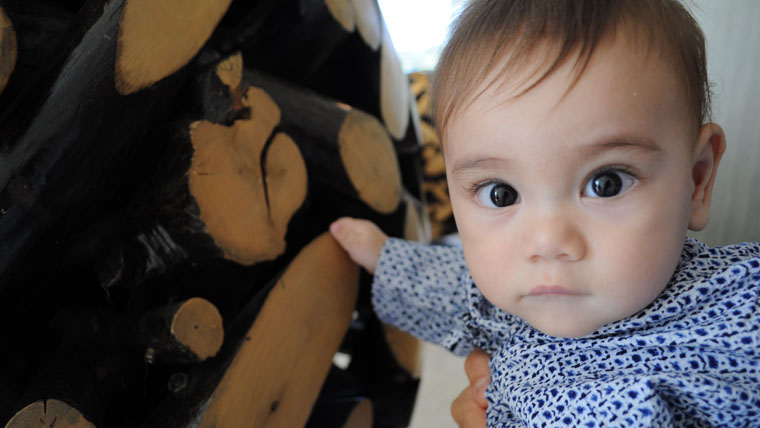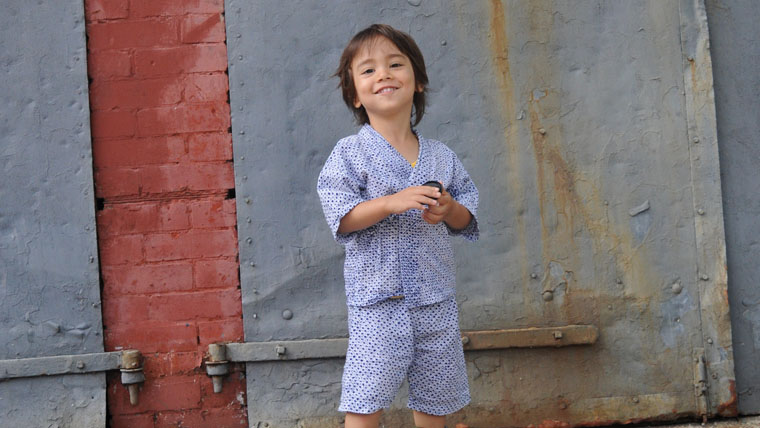Having two kids myself, I found jinbei to be some of the most versatile clothing I had for my children. A jinbei my son wore when he was only a few months old, still fit him 2 years later. Warashi-ko jinbei run big when babies are only a few months old, which is perfect for covering up sensitive skin. Then, jinbei can be adjusted by strings, so that jinbei fits perfect for multiple years. This, and my love of Japanese textiles, is why I decided to start making them myself.
All jinbei are made with the highest quality hand-dyed textiles from Japan, so not only are they durable, but they get softer and softer as they get washed! Since the cloth is hand dyed, colors will fade with time, but that is part of what gives each jinbei its unique look.
Jinbei are perfect for playing outside in the summer, relaxing at home, sleeping, etc. And since you can easily layer them under or over clothes, they are great for spring and fall too!
Each jinbei is designed by me at my Brooklyn studio, and made by either me or an artisan in Japan. Each piece is unique.
- Miya Hideshima (designer and owner of warashi-ko)
stubborn about textiles
When I started warashi-ko, I went looking for the perfect textile. I knew it had to be airy and absorbent, stay strong and bright after many washes, and be able to handle anything active kids could throw at it.
I ended up using the same hand-dyed cotton that has been used in traditional yukata (summer kinomos) for hundreds of years in Japan.
通気性・吸水性がよく、すぐ乾く。たくさん着ても洗っても、へたれず褪せない。そんなわらしっこのこだわりに応えてくれたのは、やっぱり、手ぬぐいや浴衣に使われる綿100%の手染め生地でした。
Todaya (Tokyo, Nihonbashi)
Todaya opened their business as cotton wholesaler in 1872–during Edo era (samurai period). Since 1942, Todaya has used the “chusen” technique to hand-dye yukata (summer kimonos) and tenugui (traditional hand towels). The 100% cotton, chosen by this cotton-obsessed historic shop, naturally beats everything else as material for warashi-ko j i n (jinbei = casual kimono).
Todaya produces a range of traditional and contemporary patterns throughout the year. Their colors and patterns are often surprising, but easily blend in with one another. Everyone involved with the shop contributes to creating the patterns. Some are designed by hand-dye artisans, some by employees, and even CEO contributes designs. Each textile is hand-dyed, so each one is slightly unique.
戸田屋商店(東京・日本橋)
江戸時代、綿問屋として開業した戸田屋商店。明治に注染の技法が考案されてから手染めの浴衣生地や手ぬぐいを制作。手ぬぐいも浴衣と同じ特岡という生地を使用するこだわり様。綿を知り尽くした老舗が選りすぐった生地は、文句の付けようがありません。
更なる魅力は、豊富な古典柄と、現代的な要素を取り入れた柄の数々。どちらも、色づかいや柄が斬新でも、主張しすぎることなく甚平づくりには最適。こういった柄は、どうやって生まれたのか聞いてみると、戸田屋さんでは皆がデザイナーとのこと。染め職人さんがデザインすることもあれば、女性従業員によって生まれたデザインもあり。わらしっこ営業担当さんのデザインが採用されたこともあるそう。また、手染めであるために、毎回染め上がりの印象が微妙に違うことや、稀に間違えた色で染めてしまったものも、限定色として発表する臨機応変さが素敵です。生地やデザインさることながら、とても人間味のある戸田屋さんに、わらしっこは惚れています。
Yuki Nogucih at Ahiroya Tenugui Exhibition | La Ronde d'Argile (Kagurazaka, Tokyo)
Ahiroya (Tokyo)
Ahiroya is owned by Yuki Noguchi, who is also a designer of all the Ahiroya textiles. Having a background in Yuzen technique (one of kimono hand-dyeing technique), she first designed tenugui textile in 2001. Unlike old established textile shops, Noguchi did not have connection at first, so she had to cultivate everything that's needed for entering into the world of chusen dyeing - from hand-cut stencils to dying studio.
Before hand-dying.
With the “chusen” technique, the hand-dye process involves using stencils, which are hand-cut by artisans. This makes it so even straight lines have unique character. No lines are ever exactly the same, creating a fun movement to the whole image. And just imagining that each shape is hand-cut by artisans makes my heart jump.
手染め、と一口に言うけれど、実は、その前の段階から手仕事は始まっている。例えば、注染という技法では、染色に使う型紙も職人さんの手によって作られているのです。
例えば縞。手仕事で作るから「よろけ縞」のような直線であっても直線ではない、絶妙によろけた縞が生み出されます。格子も同様。不揃いの格子が、なんとも言えない動きと愛嬌を与えてくれます。この枡は、職人さんが一つ一つ和紙を切り取って作ったものだと想像すると、満たされた気持ちになるのです。
Using the hand-cut stencils.
Unlike most machine printed textiles, where only one side is typically treated, with the "chusen" process dye goes all the way through the textile so both sides can be used. Each color is carefully applied separately to make the textile come alive.
そして、その手仕事によって作られた型紙を使って、わざわざ手染めをします。
プリントだと柄は表面に写し出されるけど、裏面は裏面。注染では、文字通り色を注ぎ込むので、裏表関係なく柄が現れます。プリントだと一手間で出来るかもしれない行程を、二手間にも三手間もかけるのが手染めです。
プリントでも出来てしまうけど、わざわざ手染め。贅沢な手間。毎回染め上がりが微妙に違う手染め。そんな手染めが愛おしいのです。




